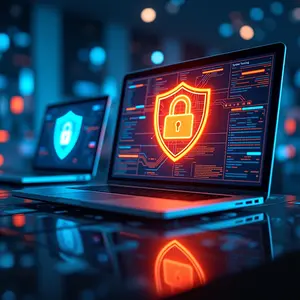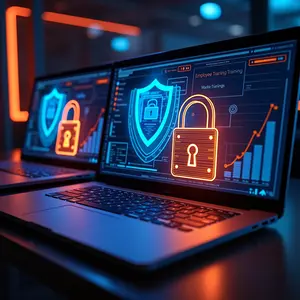Employee Training
Comprehensive employee training on IT best practices and critical cybersecurity awareness. Equip your staff to be your first line of defense. Customized programs available.
Why Is Employee Training Critical to Cybersecurity?
Employee training is a crucial defense against cyber threats, as it can mitigate the consequences of poor human decision-making. While firewalls and antivirus software are vital, they cannot fully compensate for human errors. Phishing emails, weak passwords, and improper data handling often lead to breaches. A 2023 report from Verizon revealed that 74% of data breaches involved human factors. Training empowers employees to recognize threats, respond appropriately, and follow best practices, thereby reducing organizational risk. A company learned this lesson when a staff member unknowingly clicked on a phishing link, leading to a costly recovery and disrupted operations. However, after implementing a structured cybersecurity training program, the company saw a significant reduction in successful phishing attempts over the next 12 months.

What Topics Should Be Covered in Cybersecurity Training?
Effective cybersecurity training programs cover password hygiene, phishing awareness, secure file handling, remote work policies, and the importance of software updates. Sessions should also explain the basics of data classification, insider threat mitigation, and safe use of cloud services. Interactive tools such as KnowBe4, Curricula, and Proofpoint Security Awareness Training can gamify learning and track employee progress. One organization lacked security practices due to generic, outdated training materials that failed to engage staff. After switching to a role-specific, interactive platform, engagement rose significantly, and quarterly audits showed a 60% improvement in policy adherence. Moreover, customized training aligned with job functions helps employees understand how cybersecurity relates to their daily responsibilities, not just abstract IT concepts.
How Often Should Employees Be Trained?
Cybersecurity threats evolve rapidly, making continuous learning a necessity. Best practices recommend at least quarterly refresher courses, monthly phishing simulations, and annual policy reviews. New employee onboarding must also include cybersecurity education from day one. One business provided training only during initial onboarding and saw a steady decline in compliance over time. Attackers accessed the company email when an employee reused a personal password that had been part of a breach. Compliance and awareness rebounded dramatically after introducing regular training sessions, simulated attacks, and ongoing communication through newsletters and tip sheets. A culture of continuous learning creates stronger long-term habits and resilience.
What Are the Most Common Employee Mistakes That Lead to Breaches?
Among the most frequent mistakes are clicking on phishing links, using weak or reused passwords, failing to log out of devices, and installing unauthorized software. Unintentional mishandling of sensitive data—such as emailing spreadsheets with client information to personal accounts—is also common. A sales associate once uploaded confidential contracts to an insecure Google Drive folder, exposing them to public access. Fortunately, the breach was identified quickly and damage was minimized. Nevertheless, this incident prompted the company to introduce secure file-sharing tools with limited access, enforce two-factor authentication, and integrate real-time alerts for data movement. Moreover, this scenario underscores how minor oversights can lead to significant risks without clear policies and education.
How Can Simulated Attacks Improve Employee Preparedness?
Simulated attacks are controlled exercises designed to test employee reactions to cyber threats, particularly phishing. These simulations provide real-time data on who clicked, who reported the attempt, and who ignored it. Platforms like Cofense PhishMe and Terranova Security allow customization and reporting to track improvements over time. One company ran its first phishing simulation and discovered that 42% of employees clicked the link. Shocked by the results, they implemented targeted remediation training and repeated the test two months later, with click rates dropping to 11%. Moreover, employees became more confident in spotting suspicious behavior and reporting it. Consequently, simulated attacks are not meant to embarrass staff but to teach and reinforce secure habits.

What Technologies Support Employee Cybersecurity Training?
Modern cybersecurity training is supported by learning management systems (LMS), analytics dashboards, role-based learning paths, and mobile-accessible platforms. Integration with HR systems ensures that training progress is tracked, and new hires are automatically enrolled. AI-powered adaptive learning can tailor modules based on individual performance, focusing more time on areas of weakness. A company that initially used basic slide presentations transitioned to a dynamic LMS that offered quizzes, video content, and scenario-based learning. Employee feedback improved, and knowledge retention was confirmed through quarterly assessments. Notwithstanding the investment, the system paid off with increased engagement and a marked reduction in help desk tickets related to security errors.
What Role Do Managers and Executives Play in Promoting Cybersecurity Awareness?
Leadership buy-in is a cornerstone of any successful cybersecurity training initiative. When managers and executives demonstrate secure behavior, such as using MFA, attending training, and reinforcing policies, it sends a clear message that cybersecurity is a company-wide priority. One business saw its training program gain momentum when department heads began actively participating and sharing their learning takeaways. With visible executive support, training completion rates increased, and feedback became more positive. Moreover, leadership involvement in simulations and reporting fosters a security-first culture. A top-down approach ensures that cybersecurity is not just an IT concern but a shared organizational responsibility.
How Should Success Be Measured in a Cybersecurity Training Program?
Success can be measured through metrics like training completion rates, phishing simulation click rates, policy violation counts, and incident response times. Qualitative feedback, help desk ticket trends, and employee surveys provide insights into awareness and behavioral shifts. One IT team tracked a 45% drop in password reset requests after deploying training focused on password managers and authentication tools. Moreover, quarterly assessments showed steady improvement across all departments. Notwithstanding occasional lapses, the trend indicated that employees were absorbing the material and applying it consistently. Consequently, metrics justify investment in training and identify areas needing reinforcement.
What Happens When You Get Employee Training Right?
When cybersecurity training is well-executed, employees become your greatest asset, not your most significant vulnerability. They act as vigilant sentries, spotting threats early and reporting suspicious behavior without hesitation. A tech firm once known for lax security practices underwent a cultural transformation after partnering with a cybersecurity provider to design a robust training program. Within one year, they had reduced their phishing vulnerability by 85%, passed a third-party security audit, and even had employees lead awareness events internally. Conversely, before the change, they had suffered repeated malware infections and regulatory red flags. The difference wasn’t just technical—it was organizational pride in doing things correctly.
Just Two of Our Awesome Client Reviews:
Curtis Lassingame:
⭐️⭐️⭐️⭐️⭐️
“Our employees had no clue how vulnerable we were. Reno Cyber IT Solutions gave us a training system that was easy to use and enjoyable. After just a few months, we noticed a significant drop in security slip-ups and way more confidence across the board. They made cybersecurity make sense.”
Lisa A:
⭐️⭐️⭐️⭐️⭐️
“We thought a breach would never happen to us—until it did. Reno Cyber IT Solutions stepped in, cleaned up the mess, and gave us a clear training roadmap. Now our entire team is educated, empowered, and less likely to make the same mistake again. Their support has been priceless.”
Ready to Protect Your Business?
Ready to turn your employees into your strongest cybersecurity asset? Contact Reno Cyber IT Solutions for a free consultation, and let’s design a training program tailored to your team.
👉 Learn more about our Reno-based Managed IT Services and how we help businesses build innovative, secure, and confident workforces.
👉 It’s time to level up your human firewall—let’s do it together.
Empowering employees with the right IT skills and cybersecurity awareness is a fundamental pillar of a robust and resilient organization. Comprehensive training programs equip your workforce to navigate the digital landscape safely and effectively. This includes instruction on essential IT best practices, such as password management, software usage, and data handling, as well as critical cybersecurity topics like identifying phishing attempts, understanding social engineering tactics, and adhering to security protocols. By investing in employee training, businesses can significantly reduce the risk of human error, which remains a leading cause of security breaches and operational inefficiencies. A well-trained workforce becomes the first line of defense against cyber threats and a more productive and efficient team overall.
Ongoing employee training is not a one-time event but an essential element of a proactive security and IT strategy. The technological landscape and the sophistication of cyber threats are constantly evolving, necessitating regular updates and reinforcement of training content. Continuous learning ensures that employees remain aware of the latest risks and best practices, fostering a security-conscious culture throughout the organization. Furthermore, tailored training programs can address specific skill gaps and empower employees to utilize IT resources more effectively, leading to increased productivity and a more secure and efficient operational environment. By prioritizing continuous employee education, businesses demonstrate a commitment to both security and the development of their most valuable asset: their people.
Ready to Secure and Support Your Business?
Your Reliable, Compliant, and Secure IT Partner:
Ready to Support and Secure Your Business Every Step of the Way.
